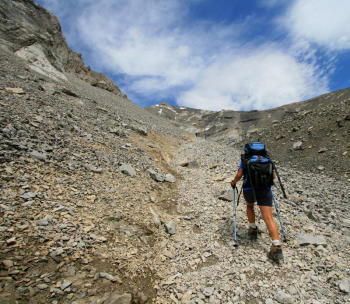 Is walking a part of your fitness routine? If so, be aware that ordinary walking is not valuable "cardio" except for the elderly and the infirm. However, walking and hiking can be perfect for a day of active recovery from a week of exercise.
Is walking a part of your fitness routine? If so, be aware that ordinary walking is not valuable "cardio" except for the elderly and the infirm. However, walking and hiking can be perfect for a day of active recovery from a week of exercise.
Assuming a person in decent health, an ordinary street walking speed for men and women is around 3 mph (3.2-3.4 for New Yorkers, which is why you get jostled). Below that is a stroll. This applies to more or less level ground. 3 mph walking is not "cardio" because the heart rate is not sufficiently elevated to challenge or strengthen the heart - or to build lower body endurance.
Deliberate hikers like to move at around 3-4 mph on level ground. I can barely hike at 4 mph (15-min/mile), especially when it's beginning to get dark and I want to get back somewhere. It's a difficult pace for me, though, because my legs want to break into a slow jog at over 4 mph instead of maintaining a vigorous walk. Some fit and experienced hikers hike at 5 mph with a backpack but at 5 I am definitely jogging, not walking, and I break into a run between after that.
Fitness level and body architecture play into this. If curious about this, your phone can give you your average speed of progress during walks and hikes unless you like to pause to look at birds and wildflowers and snakes and toads. After all, exercise is so you can enjoy life so not every hike needs to be a death march. Maybe most of them, but not all.
Best ways to improve your walking and hill-hiking efficiency? Stair machine, elliptical at the higher resistances, and fast-walking or even jogging on a good incline on a treadmill (say whatever incline you can handle if fast-walking). An hour of that is a good "active recovery" from other exercises, or good for beginners.
* In the US, normal military march is 3.4 mph (17 mins/mile), but for Army Rangers it's 4 mph.
Also, walking and jogging are not for weight loss. They are for maintaining functioning and for having fun.


 Is walking a part of your fitness routine? If so, be aware that ordinary walking is not valuable "cardio" except for the elderly and the infirm. However, walking and hiking can be perfect for a day of active recovery from a week of exercise.
Is walking a part of your fitness routine? If so, be aware that ordinary walking is not valuable "cardio" except for the elderly and the infirm. However, walking and hiking can be perfect for a day of active recovery from a week of exercise.